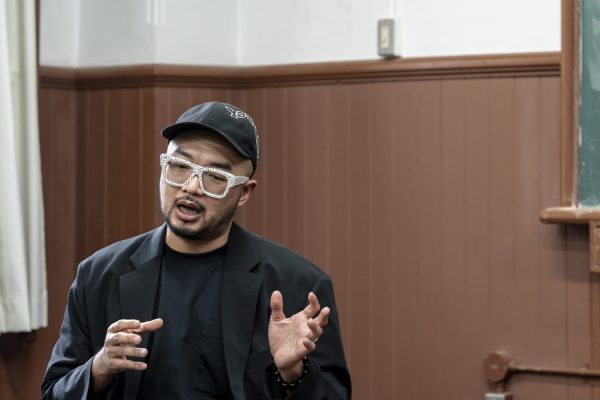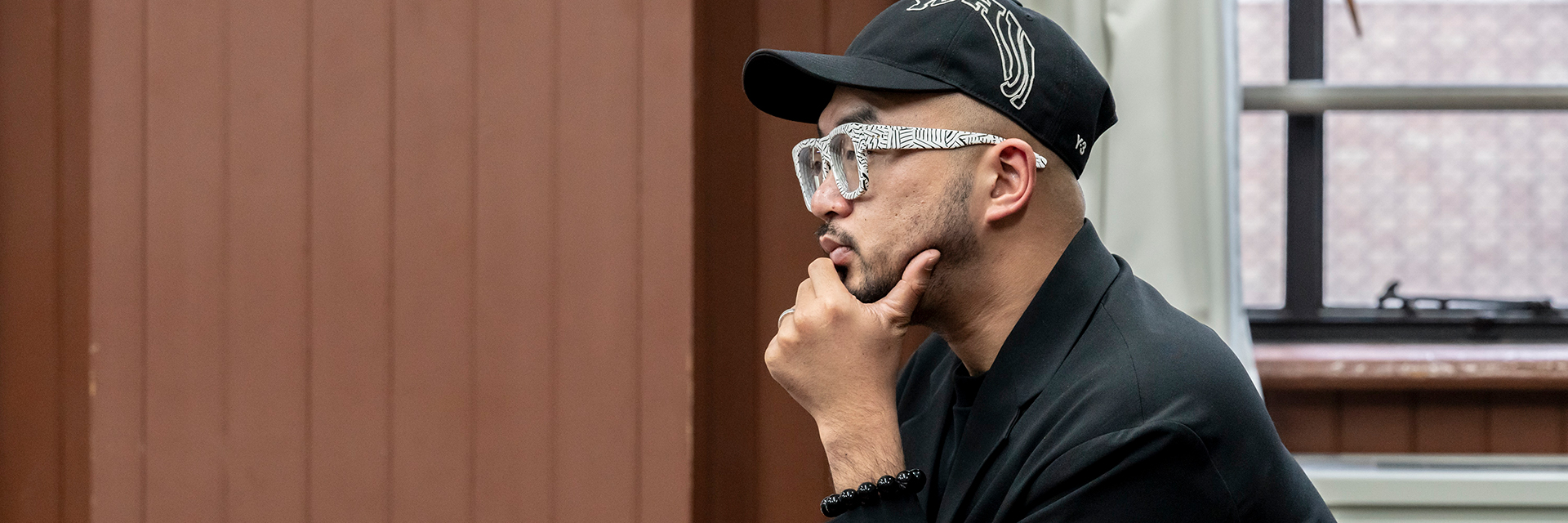
River Lin
Asia Discovers Asia – River Lin’s Performing Arts Platform from Taiwan
Photo: Yuki Moriya
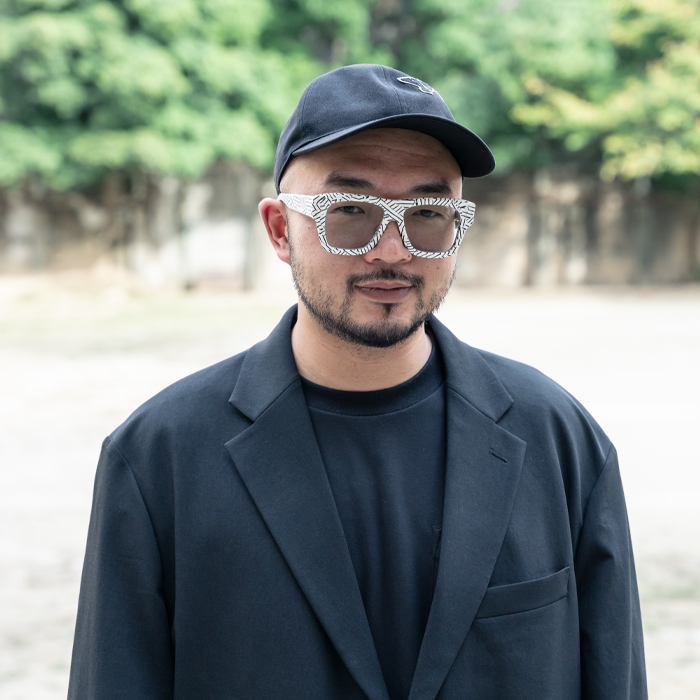
Photo: Yuki Moriya
River Lin
Born in Taiwan in 1984 and based in Paris and Taipei, Lin is an artist and curator whose work spans the contexts of performance, visual art, dance, queer culture, and more. Having established ADAM (Asia Discovers Asia Meeting for Contemporary Performance) with Taipei Performing Arts Center (TPAC), he promotes exchange between artists inside and outside the Asia Pacific region. He has curated several performing arts festivals including Camping Asia (since 2019), Indonesian Dance Festival (Co-curator since 2022), and Taipei Arts Festival (since 2023). 2025 will see Lin as guest curator at the Lyon Danse Biennale. Other recent curatorial projects include The Non-Fungible Body? with Freda Fiala in Linz (OÖ Landes-Kultur GmbH), BLEED 2022 (Arts House Melbourne and the Campbelltown Arts Center), 2057: Rehearsing Ways of Living (National Theater, Taiwan, 2022), Re:Play (Taiwan Contemporary Culture Lab, 2020), TPAM Fringe Taiwan Program (Yokohama, 2018), and more.(Updated December 2024)
Name in Chinese: 林人中
River Lin has been active in Europe as a performance artist and gradually began to feel a need to return to an Asian perspective. In recent years, he has been developing projects full of insight and ideas like ADAM (Asia Discovers Asia Meeting for Contemporary Performance) and Cruising, a project he developed as a Taipei Arts Festival curator. While working to build a platform that introduces, supports, and networks with artists in the Asia Pacific region, he is also attracting attention as a talented young curator who uses queering to break up binary dynamics such as east and west, man and woman. As co-director of the Kyoto International Performing Arts Festival KYOTO EXPERIMENT, Yoko Kawasaki has had many conversations with Lin, and here they talk about the development of Taiwan’s performing arts scene, ADAM, Cruising, and the future vision for international performing arts festivals in Asia.
Interview: Yoko Kawasaki
Japanese text: Rina Tanaka
English translation: Claire Tanaka
- Kawasaki: First, could you tell me, from your perspective, the changes in Taiwan’s performing arts from the past to the present?
- The trajectory and evolution of Taiwan’s contemporary performing arts have been inevitably linked to politics. In 1945, Chiang Kai-shek led the Nationalist Party from mainland China to Taiwan to establish the Republic of China. Before that, Taiwan was governed by Japan. In 1949, Chiang imposed martial law, ruling people’s freedom of speech with authoritarianism and censorship. People had never stopped protesting and calling for democracy, and in 1987, when martial law was repealed, students, writers,filmmakers, dancers, painters, and the like began to more openly use artistic methods to express themselves.
In the 1990s, the art scene was already very diverse. The cultural diplomacy of the United States during the Cold War had an impact on Taiwan’s theater and dance. One example is Martha Graham’s tour of Asia in 1974.1 This began a trend of intellectuals going to the U.S. to study and returning to Taiwan to showcase democratic modern theater and contemporary dance. At the same time, much of Western knowledge of philosophy, art trends, theater plays and so on was translated by independent magazines. On the other hand, there was also an underground fringe, with dissidents, anarchists and artists making parties and sound performances, working on notions such as queerness and feminism. Around this time, the national theater was putting on propaganda programming. This was also the era when the first Indigenous dance company was created.2
The 2010s saw huge institutional shifts. In 2012, the government built the Ministry of Culture to better use culture to promote Taiwan internationally. In 2014, the National Performing Arts Center (NPAC) was established, and National Theaters in Taipei, Taichung, and Kaohsiung were put under the jurisdiction of NPAC.3 This was also the period when construction began on the Taipei Performing Arts Center (TPAC), and performing arts ecosystems began to be led by those public theaters. In the past 10 years, theme-wise, we began to see a great variety of contemporary theater, dance and music productions locally and internationally, including many works of ‘contemporarized’ Chinese and Taiwanese opera (gezaixi). Indigenous artists have also increasingly made works with a focus on decolonization.
- Kawasaki: How have you worked as an artist and curator throughout Taiwan’s changing cultural policies?
- I turned my practice from a theater producer to a performance maker in the context of visual art, thanks to Seiji Shimoda’s workshop in Taipei in 2010. At that time, my interests in visual art performance and live art were not yet presented in and cultivated by visual art institutions very much. I had opportunities to do research on live art in Europe in 2014 and a 6-month residency program at Cité Internationale des Arts in Paris in 2015 with the support of the Taiwanese government to pursue my live art and choreographic practice in gallery settings; then in 2016, I moved to Paris. Since then, I have become more aware of the position of Asian artists within the European art scene, including observing how Taiwan’s government has tried hard to gain greater international visibility through presenting artists. From an artist’s perspective, I began to think about what kind of ecosystem the artistic community is co-existing with, and to be more specific, I began to think about cultural infrastructure.
My first curation with international artists in Taiwan was The Oral Movement: Musée de la Danse in Taipei featuring Boris Charmatz by TPAC in collaboration with Taipei Fine Arts Museum in 2016. I wanted to introduce artist-led knowledge and practices intersecting dance and visual art to Taiwan’s art scene so I proposed it toTPAC. Our collaboration has continued since then. I think that was when I began to use curation as a way to try to influence or infect the cultural ecosystem and infrastructure.
For a long time, international co-production in Taiwan has meant doing something with Europe or America, and Asia hasn’t been an option. Since most of the professional artists in our region have had educations rooted in the Western system, in order to develop our own artistic discourse, we need to work together and decolonize the knowledge system. The word “decolonization” may sound academic, but it’s little things like when a friend has a baby and you know it’s a girl, you feel obligated to send something in pink; if it’s a boy, in blue. Also, Christmas automatically equals snow and Santa Claus. Colonialism is a situation where images like these are occupying your mind. I felt an urgent need to bring Asian-Pacific artists together so we could learn from each other and practice together to gain our own vocabulary and knowledge.
However, in East Asia, many public institutions are pressured to be hyper-productive, rather than supporting an artist’s research and cultivation. There is a trend of asking for works to be produced at a high standard, works that can be sent out to the international market, Europe in particular. This is why I felt a need to do something that didn’t expect outcome from artists but first emphasized getting to know one another and building networks when I began ADAM (Asia Discovers Asia Meeting for Contemporary Performance) in 2017.4 It’s a platform for artists to get together and do their collective research while developing an artist-led network. Since we don’t require any deliverables, it may seem unproductive to some people. When presenting a work-in-progress, the audience and buyers’ reaction would be, “What was that?” But for artists, it’s very important to have that process. Cultural institutions have to create a supporting system for creation and a space for development for artists.
- Kawasaki: I feel like that the fact that ADAM is a platform for exchange, rather than presenting works, is critical for Asia to be able to build a common foundation in performing arts. It began in 2017, and endured through the coronavirus pandemic. What do you have in mind for ADAM now?
- Allowing artists to meet through ADAM and develop new ideas and collaborations, it’s important for the artists themselves to take the lead. At ADAM, artists who have participated would be invited the following year to design the program as guest curators. Some artists would be invited to come back to present work-in-progress. This method has created a circulation where artists are empowered to expand their findings and development, to disturb a normative and one-off production-orientated framework. For example, at the second ADAM Artist Lab in 2018, Natsuki Ishigami participated as an artist,5 and at the third in 2019, I invited her to be a curator for the Artist Lab.
The collaboration between Nanako Matsumoto and Anchi Lin began this way. At this moment, ADAM’s Artist Lab program comes to the point of expanding the supporting system by working more closely with international partners. For 2024, in collaboration with BIPAM, we have invited its Artistic Director Sasapin Sirivanit as guest curator and co-curated a program in which participating artists will conduct research and presentations in both Bangkok and Taipei to form an inter-Asian context.
- At the 7th ADAM (2023) where Anchi was guest curator for Artist Lab and Matsumoto was participating as an artist, that was the start of their collaboration where they created the Sticky Hands, Stitched Mountains project,6 which was created as an international co-production by the TPAC, KYOTO EXPERIMENT, and the Japan Foundation. During the post-show talk after the world premiere at the Kyoto performance, Matsumoto said, “During my residency at ADAM, I was constantly aware of the historical context of being ‘a person from a country that colonized Taiwan’ as I reflected on my own position. In that process, I found it incredibly difficult to find the words to talk about my experiences of being in Taiwan.” I think that a result of this creation she did with Anchi, she found those words while being forced to touch upon those things which can be difficult to touch.
- The great thing about that project is that it’s not as though you or I encouraged them to collaborate, but they were just attracted to each other and formed it themselves. In addition to a feminine perspective, in Sticky Hands, Stitched Mountains Anchi added an indigenous Taiwanese perspective, and it’s a rare attempt to re-interpret the relationship between society and supernatural beings. This sort of decolonial dialogue is what can help us understand the
Intra-Asian context in a richer way.
-
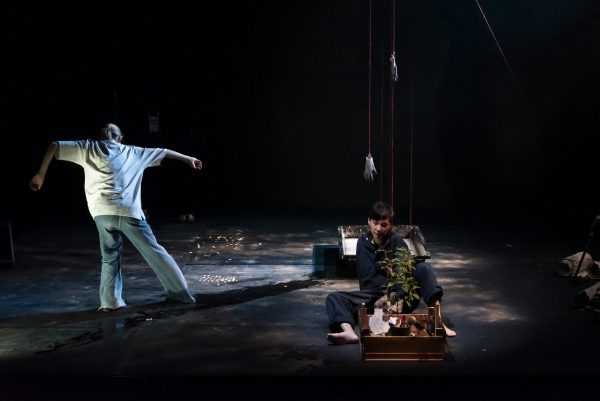
Nanako Matsumoto & Anchi Lin (Ciwas Tahos), Sticky Hands, Stitched Mountains, 2024.
Photo: Haruka Oka. Courtesy of Kyoto Experiment.
- Kawasaki: I’ve been to ADAM many times, and it feels to me like it has become a place for artists to gather, not just for Taiwanese artists, but for artists from other regions as well. Japan’s official cultural support is based on the idea that by supporting the growth of our own artists and making our own country’s culture richer, our international presence will grow. How do you handle the fact that ADAM receives public funding yet also supports artists that are not Taiwanese?
- I think it’s natural that governments only support their own country’s artists. ADAM is a unique case of generosity with resources for non-Taiwanese artists. I believe that it’s meaningful to build this environment where, for example, people from Southeast Asia, whose freedom of speech is not guaranteed at home and are limited in their access to research and creation can come to Taiwan and express themselves freely. It would be nice if public support systems could be a little more flexible.
When it comes to curators and directors, there is international exchange happening. In Japan, Leonhard Bartolomeus of Indonesia has been a curator for Yamaguchi Center for Arts and Media (YCAM), and Singapore’s national performing arts center, The Esplande, has Izumi Asakawa as a producer. In Taiwan, Singapore’s Tang Fu Kuen was a curator for the Taipei Arts Festival.
However, I am also rethinking how ADAM can continue to coexist with public institutions. When I began ADAM, TPAC was still under construction until its opening in 2022. With such an investment of capital to build the facility, they can’t help but have high expectations for production, and the Taipei city and Taiwanese government are put in a position of having to foster these expectations. Still, I think ADAM has had a good impact on other sectors in Taiwan.
Lately, National Theater & Concert Hall (NTCH) in Taipei is turning its attention to Asian artists and supporting research done by young artists.
- Kawasaki: You brought up the Taipei Arts Festival. I feel like the Taipei Arts Festival with its goals of public performances and presentations, and the way ADAM’s goals are not necessarily public performances, have an organic symbiosis. As curator of both projects, what do you consider to be the roles of each?
- Just to organize the timeline, ADAM was made in 2017, and the following year Tang Fu Kuen became curator of the Taipei Arts Festival, and that is where our collaboration began. For example, Chikara Fujiwara participated in the first ADAM (2017) which led to IsLand Bar (Taipei Arts Festival, 2018). The pattern is emerging for artists to be able to develop a production at ADAM and present it at the Taipei Arts Festival. Since I became a curator for the Taipei Arts Festival in 2023, the ties between the festivals have gotten even deeper.
- Kawasaki: I want to ask you about Cruising at the Taipei Arts Festival program. The guest curator for Cruising varies every year, and a new project is launched. In its first year in 2023, Helly Minarti of Indonesia made The Sea Within, and in 2024, the director team of KYOTO EXPERIMENT made Traveling Tongues. Next year the curator will be the current Creative Director of the Asia-Pacific Triennial of Performing Arts (Asia TOPA), Jeff Khan. How did the structure of Cruising come about, where curators of different backgrounds overlap as they work?
- When I was approached by TPAC about curating the Taipei Arts Festival from the 2023 edition, I pondered the meaning and repositioning of festival making and how it can go beyond presenting shows. Ecosystem and network have been keywords when I initiate curatorial projects. I looked at Google Maps [laughs] and wondered how this festival of the capital city could be not only a city festival but also a festival of an island, and what’s the dialogic relationship between this island and other islands in the ecosystem of the archipelago. To the north of Taiwan is Japan and to the south is the Philippines and Indonesia archipelago. In particular, Indigenous Peoples of Taiwan are connected to this mapping of the Austronesian archipelago including Australia and New Zealand, therefore a common thread of the cultures of the Pacific archipelagos began to emerge. If festivals and curators in this region have collaborative and curatorial dialogues with each other, what kind of curatorial ecosystem and radical care7 of Asia Pacific can we imagine further? This is how I formed this curator-in-residence project within Taipei Arts Festival.
On the other hand, the word “cruising” has a background in colonialism since the Age of Discovery. So-called Formosa (another name for Taiwan in Portuguese) is one island that was discovered in such a way. Additionally,“cruising” has been a slang term in gay culture,8 and it was used with negative implications in the same way as “queer.” So for this festival, I thought to redefine the word “cruising” as a curatorial method and suggest a journey of dialogue to decolonize ourselves and a reflection to festivals and their curation. Thus “cruising” invites and encourages artistic and curatorial proposals and dialogues between curators and their invited artists through research-based speculation and ideas, so their curatorial network can expand. I’m looking forward to next year’s premiere of Traveling Tongues.
-
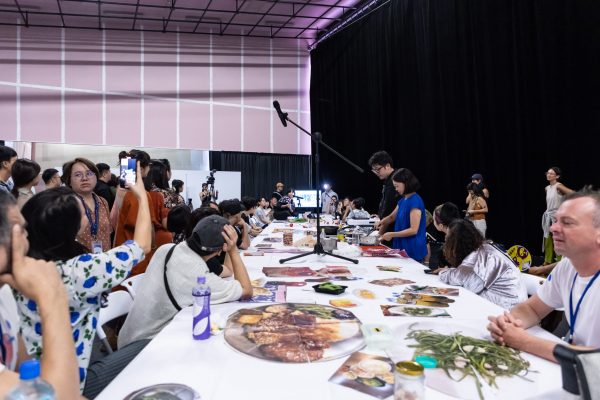
“Traveling Tongues” Research Sharing(2024 Taipei Arts Festival)Photo: Grace Linrn
- R. Tanaka: Around 2021, you cited the concept of a queer museum, and discussed adapting the word queer for curation, rather than just for describing things like identity and gender.9 How does queerness relate to curation for you?
- Queerness and queer becoming has been the primal way of thinking for my projects and practice. When approaching cultural ecosystems, the act of making systems and organizations queer, or queering institutions, is not about opposing or resisting systems and organizations. It refers to making a place where we can share alternatives co-existing with the mainstream and make systems and organizations more inclusive. Everything I’ve talked about today is based in this concept.
- Kawasaki: Finally, while we work to create curation from an Asian perspective, on the audience side, there is a strongly rooted tendency to prefer famous European works, and that’s just reality. In particular when inviting an artist for the first time, that is a high hurdle for the audience, and so I try to introduce that person’s social background as much as possible, and after that, I try to have them reappear as part of a residence program or collaboration, in order to help the audience connect the dots and deepen their understanding of that artist. For example, Wichaya Artamat was introduced at KYOTO EXPERIMENT 2021 SPRING, and he did research in Kyoto in 2022 and staged an international co-production with Japanese artists in 2023. Publicly funded programs like KYOTO EXPERIMENT don’t have to focus solely on artists with potential for commercial success, so I think it has an important role in introducing artists who may be younger or less well-known but are nonetheless doing important work. What do you think about this issue?
- For a long time we were all used to learning that ‘international work’ meant something done by white Western artists. It’s only very recently that things other than European works began to be introduced at Asian festivals. It’s very recent. In my first edition of 2023 Taipei Arts Festival, I invited Robyn Orlin from South Africa, and Faustin Linyekula from the DR Congo. It was challenging to promote artists that weren’t well-known in Taiwan. But once the curtain opened, after the first show, the word of mouth spread rapidly on Instagram and it was received well. People started to learn from stories of the artists and get to know African history and how it’s relevant to Asia. We have to just do it. Once we begin, changes will happen and it’s never too late.
That’s why I say, “Just do it!” There is no other way, after all.
Interpretation: Miho Tsujii
-
Martha Graham’s tour of Asia in 1974
In 1974, Martha Graham, with support from the United States State Department, toured Burma, Hong Kong, Indonesia, Japan, Malaysia, Philippines, Taiwan, Singapore Thailand, and Vietnam.
-
the first Indigenous dance company was created
For example, The Formosa Aboriginal Song and Dance Troupe was founded in 1991 by Faidaw Fagod of the Amis tribe and Snaiyan of the Puyuma tribe.
-
National Theaters in Taipei, Taichung, and Kaohsiung were put under the jurisdiction of NPAC
The National Taichung Theater (opened in 2016) located in Taichung, and the National Kaohsiung Center for the Arts in Kaohsiung (opened in 2018) came under the jurisdiction of TPAC along with the National Theater and National Concert Hall built in Taipei in 1987. The Taipei Performing Arts Center is under the jurisdiction of the Taipei City Government.
-
ADAM
In 2022, a publication was released by the Taipei Performing Arts Center entitled “The Networked Body: the Culture and Ecosystem of Contemporary Performance” (not translated). https://riverlin.art/project
-
at the second ADAM Artist Lab in 2018, Natsuki Ishigami participated as an artist
During the third ADAM, Ishigami Natsuki established the Taipei City Community Research Project “Performing (with/in) communities: Relations, Dynamics and Politics.”
-
Sticky Hands, Stitched Mountains project
Sticky Hands, Stitched Mountains was generated from ADAM 2023, and premiered as part of the KYOTO EXPERIMENT 2024 program. It is scheduled to have its Taipei iteration in September 2025 as part of Taipei Arts Festival.
-
radical care
Radical care is a form of collective care that originated in antiracist and feminist movements. In Radical Care: Survival Strategies for Uncertain Times(2020), Hobart and Kneese introduce radical care as a survival way of marginalized communities to build an alternative to structural inequality as a result of historical colonialism and neoliberalist society.
-
“cruising” has been a slang term in gay culture
Cruising began as a slang term for men seeking one-time sexual partners, but over time as the term became more common it began to have a homophobic meaning.
-
the word queer for curation, rather than just for describing things like identity and gender
A YouTube broadcast by Thinkers’ Studio entitled “Connect with SEA (Gender Issue): Residency in the CLOUD|Visualizing Networking for Gender Issues Based Creation” (co-hosted by Dance Nucleus, June 12, 2021) .
-
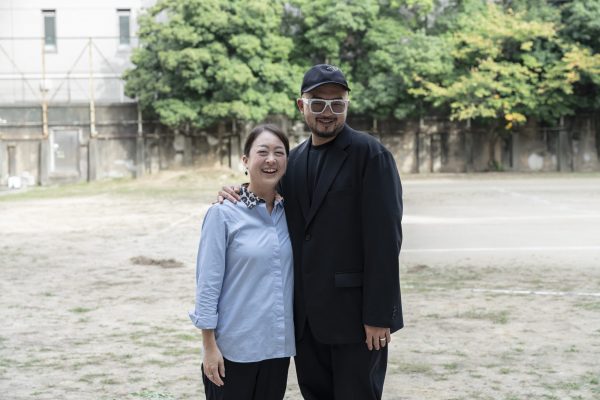
with interviewer Yoko Kawasaki Photo: Yuki Moriya
Special thanks to KYOTO EXPERIMENT, KYOTO ART CENTER
Related Tags




